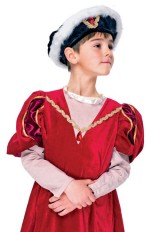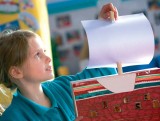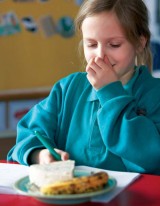Dave Lewis shows you how to turn the sinking of the Mary Rose into a science experiment as part of his cross-curricular Tudor topic...
On July 19th 1545, King Henry VIII stood atop the keep at Southsea Castle ready to witness yet another battle in the long running Anglo-French conflict. His Royal Navy sailed before him, begun in the time of Henry V and brought to the forefront of Britain’s armed forces during his reign.
The pride of his fleet was the Mary Rose, a beautiful warship named after his favourite sister and the Tudor emblem.
As the French began the engagement, the Mary Rose turned to fire on the enemy, listed, took on water through its gun ports and sank.
Henry was distraught and courtiers were brought in to spin the bad news. The nation couldn’t be allowed to think the unthinkable: that the French had managed to sink its finest vessel.
For the next 300 years people believed the official story, that a freak wave had swamped and sank the ship. Then, in 1836, a group of fishermen tangled their nets around an underwater object. When divers were called in to release the nets, they inadvertently discovered the Mary Rose.
However, the site of the wreck soon became forgotten, that is until 1970 when an archaeologist searching the Solent for wrecks came upon a piece of her timber and a cannon. More pieces were brought up the next year and a study began to ascertain whether she could be raised to the surface.
In 1979 the dream came true, watched by millions on television, and now the Mary Rose has returned home to a museum in Portsmouth.
I visited the museum (maryrose.org) in the Historic Dockyard area of the city with my class and we discovered a huge amount about Henry VIII’s favourite ship, the time she was built, the life of the men on board and the day of her sinking. We were also given a fascinating insight into the work that has gone into restoring and preserving her.
Not all schools will be so lucky, so I’ve prepared some cross curricular activities that will help you make the most of the 500th anniversary of her launch.
 We found that drama helped to introduce the context of the Mary Rose activities and we began by setting the scene of conditions on board ship. You can do this simply with the following short activities. On many ships the headroom below deck as only just over 4ft and the sailors had to stoop, even though they were shorter than modern day people. Pin a sheet of cardboard between the uprights of the class door frame at just over four feet and make the (older and taller) children stoop o go through or stand under the card to see how uncomfortable it must have been. It was also very dark, so you might want to turn out the lights as well. Ask the children about the risks of working in such conditions.
We found that drama helped to introduce the context of the Mary Rose activities and we began by setting the scene of conditions on board ship. You can do this simply with the following short activities. On many ships the headroom below deck as only just over 4ft and the sailors had to stoop, even though they were shorter than modern day people. Pin a sheet of cardboard between the uprights of the class door frame at just over four feet and make the (older and taller) children stoop o go through or stand under the card to see how uncomfortable it must have been. It was also very dark, so you might want to turn out the lights as well. Ask the children about the risks of working in such conditions.
The main challenge for the gun crews was to get the cannons loaded, fired, then reloaded quickly so that they could defeat the enemy. Try recreating this with your class. Use a piece of wide drainpipe, some sand to represent the gunpowder, an orange or grapefruit for the cannonball and a broomstick with a circle of wood or plastic on the end as the packer. Put the children into gun crews, each with a different job: firer, powder monkey, cannonball fetcher and packer. Now either time each crew to see how quickly they can fire their cannon or race crews against each other. Get them to follow commands from one person: ‘Powder’, ‘Pack’, ‘Cannonball’, ‘Pack’, ‘Clear space’ and ‘Fire’.
Tip
Show the children some x-ray pictures of broken bones. Tell them they were from sailors on the Mary Rose and ask them how you think the bones were broken.
Mock up the side of a ship with card strips over a thin wooden frame and throw (fire) an orange at it to look at the damage. Discuss how it would have been repaired whilst at sea.
Marine archaeologists have been trying for years to discover why the Mary Rose sank so quickly. They have investigated the wreck itself as well as carrying out numerous experiments with models. Here, children will take on the role of marine archaeologists to find out for themselves what might have gone wrong.
A freak wave and a strong gust of wind have been blamed for the sinking and children should experiment with both to see which is the most likely cause.
Resources:
• Standard card cereal packet about 30 cm x 20 cm x 5 cm, turned inside out
• Child safe varnish (use wood glue if varnish is unavailable)
• Colouring pens, safety craft knives, paper
• Video camera
• Paddling pool
• Dowel
• Predictions and results charts
Prior to the lesson, add a measured quantity of gravel to the inside of a cereal box. Now turn the box on its side, place it gently into water and mark the depth of displacement. Adjust the ballast as necessary so that a quarter of the box is underwater.
 In the lesson, ask the children to decorate the box like a medieval warship and to carefully cut out gun ports. Now they should reconstruct the box before coating the lower two thirds with varnish or glue, being careful to pack any gaps with glued or varnished paper.
In the lesson, ask the children to decorate the box like a medieval warship and to carefully cut out gun ports. Now they should reconstruct the box before coating the lower two thirds with varnish or glue, being careful to pack any gaps with glued or varnished paper.
When the glue is dry, add a paper sail to a dowel that can be turned to the front or side of the ship and begin the tests.
Use a small inflatable paddling pool and fill it to a depth of about six inches. (Make sure risk assessments have been carried out. It may be worth setting this up in a room that can be locked to prevent unauthorised access.)
Ask the children to add the amount of ballast that you measured earlier to the base of their boats. Now the model ships can be placed in the pool, two or three at a time.
Tell the children you are going to use a plank of wood that’s the same width as the pool to push a wave towards the boats, meeting them nose on. Ask them to predict what will happen to their boats. How will they move? Will they stay afloat?
Repeat the experiment but this time ensure that the wave hits the boats side on. Ask the children if they can predict a different outcome. If possible, it’s useful to position a video camera to the side of the pool so the experiment can be played back later.
Now use more boats and repeat the experiment using the air from a fan to recreate a strong gust of wind. Try the experiment with the boats end on with the sails perpendicular to the wind, then in line with the wind. Repeat this experiment with the hulls perpendicular to the wind and ask the children to predict the outcomes.
Tip
The children can recreate the holes made by cannonballs by pushing a sharp pencil through the side of the box. If they look inside they’ll see how the damage might have looked from within the ship. (Stuff the boat with newspaper first to stop the sides collapsing and to prevent accidents.)
If their boat takes on water, ask children to make temporary repairs to save the boat.
 In Tudor times, a ship going to sea, especially in hostile waters, would need to store all its supplies for the trip on board. (Remind the children that there were no fridges or freezers, nor any tins to help preserve food.)
In Tudor times, a ship going to sea, especially in hostile waters, would need to store all its supplies for the trip on board. (Remind the children that there were no fridges or freezers, nor any tins to help preserve food.)
The crew would take plenty of fresh food for the start of their journey and eat this until it started to go off. Then they would survive on food that had been dried or pickled in brine or vinegar.
This next experiment challenges children to investigate how long different foods would have lasted on board ship. The idea is for children to decide on a suitable list of ship’s provisions based on their findings.
Resources:
• Various food items
• Plates
• Plastic gloves
• Camera
• Results chart
With the children, discuss what types of food may have been available in Tudor times. Examples will include bread, plain biscuits, apples, pears, turnips, cabbage, cheese and milk. Don’t choose food that could become a health risk, such as meat or eggs.
The children should take photographs of the foodstuffs and place them somewhere out of reach of others where they can be left to age. The storage area should be ventilated to prevent the build up of airborne microbes.
Monitor the foodstuffs over the course of three weeks, photographing them at regular intervals. The foodstuffs can be touched (preferably through gloves) but not tasted. The children should notice a difference in appearance and texture over time. Differences should be recorded on paper too and the children should decide at which point they consider the food to be inedible.
Using this information and the fact that the crew of a warship was probably around 250 men, they should work out a ship’s supply list to last them until the food would become inedible.
Have a discussion about what dried foods might have been available and whether any foods could have been made on board. Ideas might include grain, dried fruit, dried fish and meat. As homework you can ask the children to add to their information by checking the expiry dates of similar foodstuffs at home or in the supermarket. Suggest that they look at organic produce where possible as it is unlikely to have preservatives in it.
Eventually, the children should gain a picture of how a mix of dried, preserved and fresh foods kept sailors alive on long voyages. A further extension could be to look at the history of food preservation, which is closely linked with the armed forces.
Useful websites
maryrose.org
woodlands-junior.kent.sch.uk
historicdockyard.co.uk
Tip
Use a microscope to look more closely at the decay. Anything over 200x should give a good image of the decay to add to your display.
Try your own pickling. Many veg are pickled, including onions, gherkins and beetroot. Spend a session pickling onions or similar. Give it a couple of months and see which looks best.
Have a tasting session when you reconstitute dried foods such as potato, milk, rice,dried peas, dried onions etc. Discuss how closely they taste like the fresh article.
Quick activities for your Mary Rose topic…
• Debate why you think the Mary Rose sank
• Find out more about the Battle in the Solent
• How much wood was used to make a warship?
• Create a fact file about the Mary Rose
• Write a diary about your life on board as a sailor or even the ship’s cook!
• Produce a timeline for the story of the Mary Rose
Why Boarding School Fiction Feels Comfortably Familiar
Ace-Classroom-Support
Pie Corbett’s bike poems
Topic
Use the bottle-flipping craze to create good school behaviour, not bad
Behaviour Management
